
1introjunos
.pdf
Introduction to JUNOS Software
Permissions (contd.)
•flow-tap: Allows the viewing of flow-tap configuration;
•flow-tap-control: Allows the modifying of flow-tap configuration;
•flow-tap-operation: Enables the tapping of flows;
•idp-profiler-operation: Enables IDP profiler;
•interface: Allows the viewing of interface configuration;
•interface-control: Allows the modifying of interface configuration;
•maintenance: Allows system maintenance, including starting a local shell on the device and becoming the superuser in the shell, and can halt and reboot the system;
Not
•network: Allows network access;
•reset: Allows the resetting and restarting of interfaces and processes;
•rollbackReproduction: Allows the ability to roll back for depth greater than zero;
•routing: Allows the viewing of rout ng figuration;
•routing-control: Allows the mod fy ng f r uting configuration;
•secret: Allows the viewing of se ret onfiguration;
•secret-control: Allows the modifying of secret configuration;
•security: Allows the viewing of security configuration;
•security-control: Allows the modifying of security configuration;
•shell: Allows the starting of a local shell;
•snmp: Allows the viewing f SNMP configuration;
•snmp-cont ol: Allows the modifying of SNMP configuration;
•syst m: Allows the viewing of system configuration;
•syst m-control: Allows the modifying of system configuration;
•trace: Allows the viewing of trace file settings;
•t ace-control: Allows the modifying of trace file settings;
•view: Allows the viewing of current values and statistics; and
•view-configuration: Allows the viewing of all configuration (not including secrets).for
The configurable permissions might vary between JUNOS platforms and software versions. Refer to the technical publications for your specific device and version of JUNOS Software.
Allow and Deny Overrides
You can use the deny-commands, allow-commands, deny-configuration, and allow-configuration statements to define regular expressions that match operational commands or configuration statements. Matches are explicitly allowed or denied, regardless of whether you set the corresponding permission flags. The JUNOS Software applies the deny- statements before the corresponding allow- statements, resulting in the authorization of commands that match both.
Secondary System Configuration • Chapter 5–13
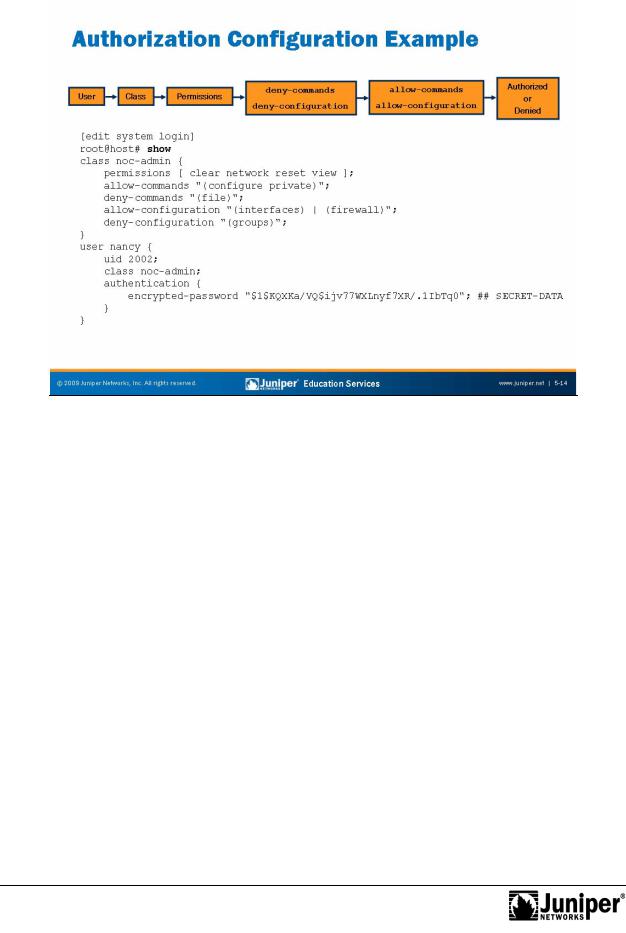
Introduction to JUNOS Software
|
Reproduction |
|
|
|
|
||
Authorization Example |
|||
The configuration example the slide shows how the various authorization |
|||
for |
|||
components a e configured: |
|||
• |
User nancy is a member of the noc-admin class; |
||
• |
The n c-admin class has the clear, network, reset, and view |
||
|
permissions; |
||
• |
In addition, the noc-admin class can enter configuration mode using |
||
|
the configure private command and is allowed to alter |
||
|
configuration parameters at the [edit interfaces] and [edit |
||
|
firewall] hierarchy levels; and |
||
• |
The noc-admin class is denied the ability to manipulate files using the |
||
Not |
operational mode’s file command and is specifically excluded from |
||
|
navigating to or viewing configuration details at the [edit groups] |
||
hierarchy level.
Chapter 5–14 • Secondary System Configuration
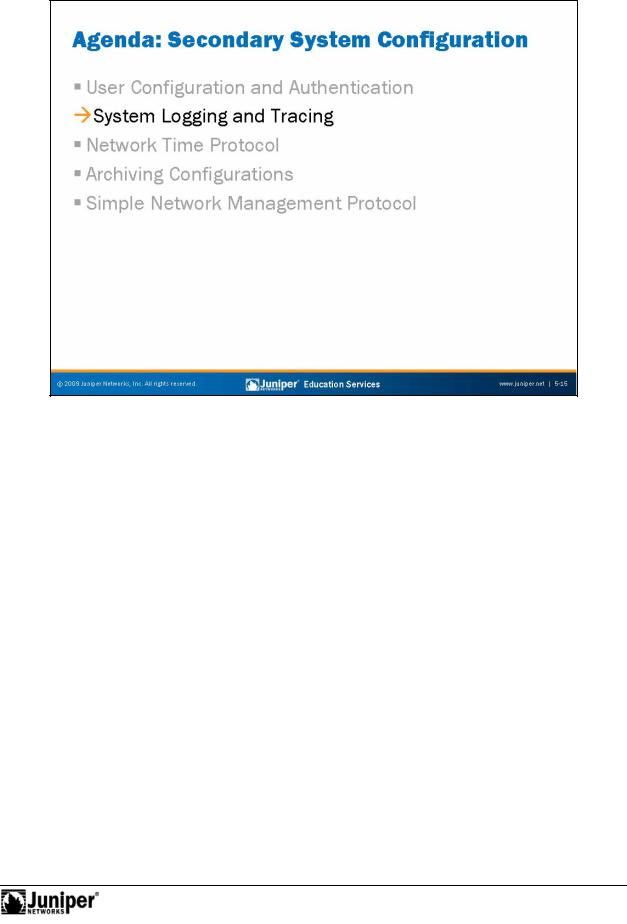
Introduction to JUNOS Software
|
|
Reproduction |
|
System Logging and Tracing |
|
|
The slide highlights the topic we discuss next. |
|
Not |
for |
|
|
|
|
Secondary System Configuration • Chapter 5–15
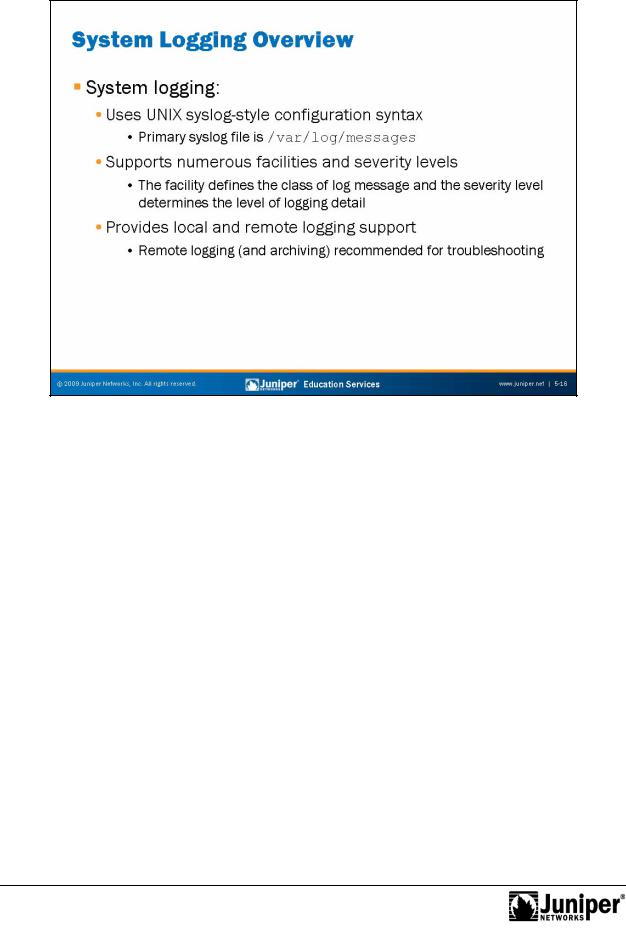
Introduction to JUNOS Software
System logging (syslog)Reproductionoperations use a UNIX syslog-style mechanism to record system-wide, high-level operations, such as interfaces going up or down or users
logging inforto out of the device. JUNOS Software places the results of the logging operations in files that are stored in the /var/log directory. The primary syslog file, which is included in all factory-default configurations, is the /var/log/messages file.
NotJUNOS S ware supports a number of facilities and severity levels. The facility is listed first and defines the class of log messages. The severity level is listed second and determines the level of detail to be logged.
Syslog information can be logged to individual files, such as the /var/log/ messages file, or it can be sent to a remote server. Remote logging and log file archiving is recommended to aid in troubleshooting efforts.
Chapter 5–16 • Secondary System Configuration
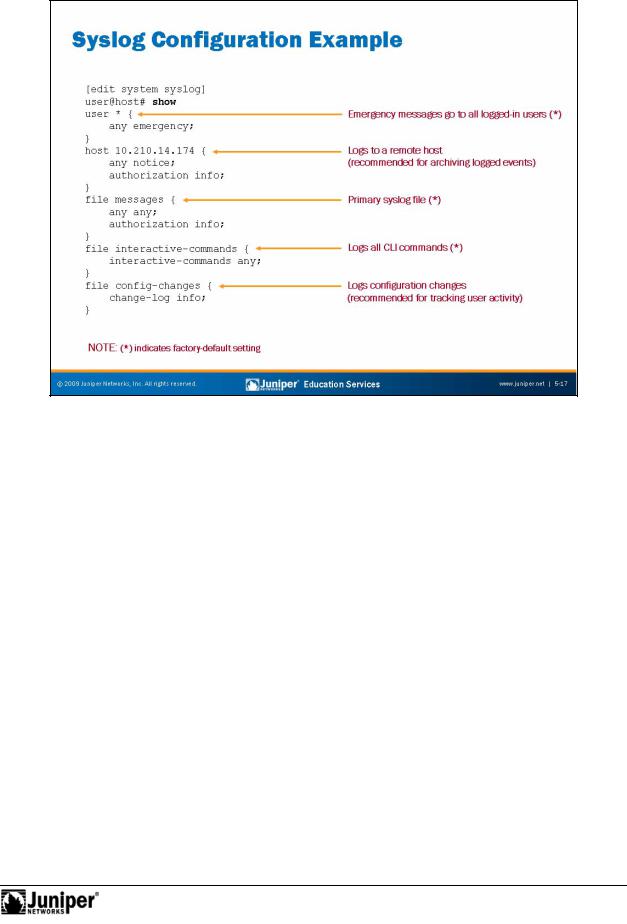
Not
Introduction to JUNOS Software
Syslog ConfigurationReproductionExample
The slide shows various syslog configuration examples including a number of the default settings. Syslog operations can be enabled or modified at the [edit system syslog] hierarchy level and the [edit routing-options options sysl g] hie archy level. General syslog configuration options include the following:
• |
host name or IP address: Sends syslog messages to a remote |
|
for |
host—typically a UNIX device configured to receive incoming syslog |
|
messages; |
||
archive: Configures how to archive system logging files (default is to |
||
• |
||
|
keep 10 archive files with a maximum size of 128 K each); |
|
• |
console: Configures the types of syslog messages to log to the system |
|
|
console; |
|
• |
facility: Displays the class of log messages; |
|
• |
severity: Displays the severity level of log messages; |
|
• |
file filename: Configures the name of the log file; and |
|
• |
files number: Displays the maximum number of system log files. |
Secondary System Configuration • Chapter 5–17
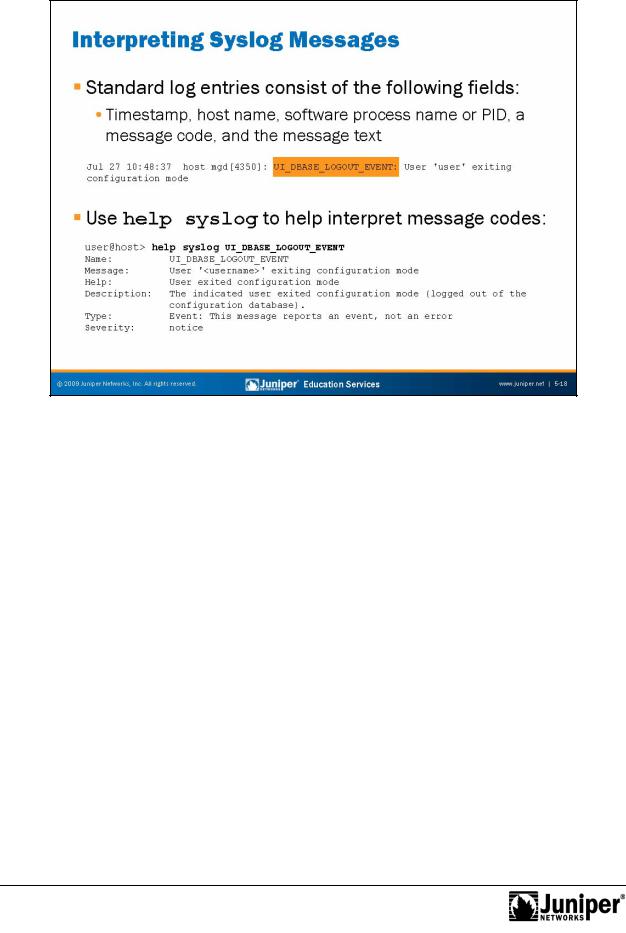
Introduction to JUNOS Software
Interpreting System Log Entri s
When using the standard syslog format, each log entry written to the messages file |
|
consists of the following fields: |
|
• |
timestampReproduction: Indicates when the message was logged; |
• |
name: Displays the configured system name; |
• |
Process name or PID: Displays the name of the process (or the |
|
process ID when a name is not available) that generated the log entry; |
|
for |
• |
message-code: Provides a code that identifies the general nature and |
|
purpose of the message. In the example shown, the message code is |
|
UI_DBASE_LOGOUT_EVENT; and |
• |
message-text: Provides additional information related to the message |
Not |
code. |
|
|
When you add the explicit-priority statement, JUNOS Software alters the syslog message format to include a numeric priority value. In this situation, the value 0 indicates the most significant and urgent messages (emergency), and 7 indicates debug-level messages.
Continued on next page.
Chapter 5–18 • Secondary System Configuration

Introduction to JUNOS Software
Interpreting Message Codes
Consult the System Log Messages Reference documentation for a full description of the various message codes and their meanings, or, better yet, use the CLI’s help function to obtain this information. The example on the slide shows the operator obtaining help on the meaning of the UI_DBASE_LOGOUT_EVENT message code. Based on the output, you can clearly see that the message code shows a command that a user entered at the CLI prompt.
|
for |
Reproduction |
Not |
|
|
|
|
Secondary System Configuration • Chapter 5–19
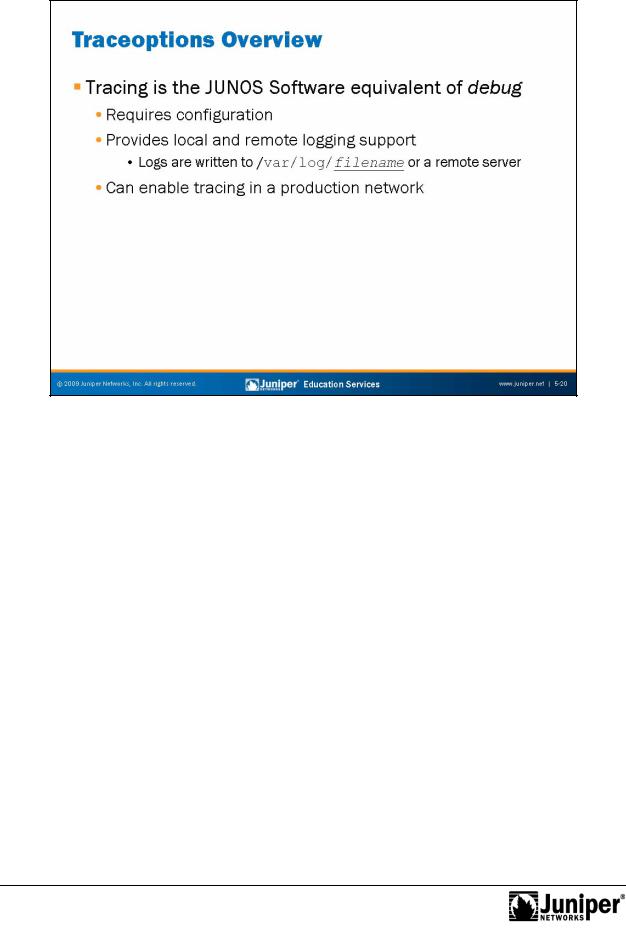
Introduction to JUNOS Software
Hear Tracing, Think D bug
Tracing is the JUNOS Software term for what other vendors sometimes call debug. In most cases, when you enable tracing (through configuration), you create a trace file that is usedforto sto e decoded protocol information received or sent by the routing
engine. JUNOS S ftwaReproductionsends the tracing results to a specified file stored in the /var/l g direct ry or to a remote syslog server. To enable remote logging, specify a syslog server at the [edit system tracing] hierarchy level as shown in the
Notfollowing screen capture:
[edit system tracing] user@host# show
destination-override syslog host 1.1.1.1;
Continued on next page.
Chapter 5–20 • Secondary System Configuration

Introduction to JUNOS Software
Hear Tracing, Think Debug (contd.)
You might see a warning when using the remote syslog server option. If the syslog server is configured properly and you have verified that the logs are being received on the server, you can safely ignore the warning. The following is a sample warning:
[edit]
user@host# commit [edit protocols ospf]
'traceoptions'
warning: No file specified.
commit complete |
|
|
|
Because of the design of JUNOS Software, you can enable detailed tracing in a |
|
|
production network without significantly impacting performance. Even so, you should |
|
|
|
Reproduction |
|
always remember to turn off tracing once you have completed your testing to avoid |
|
|
unnecessary resource consumption. |
|
Not |
for |
|
|
|
|
Secondary System Configuration • Chapter 5–21
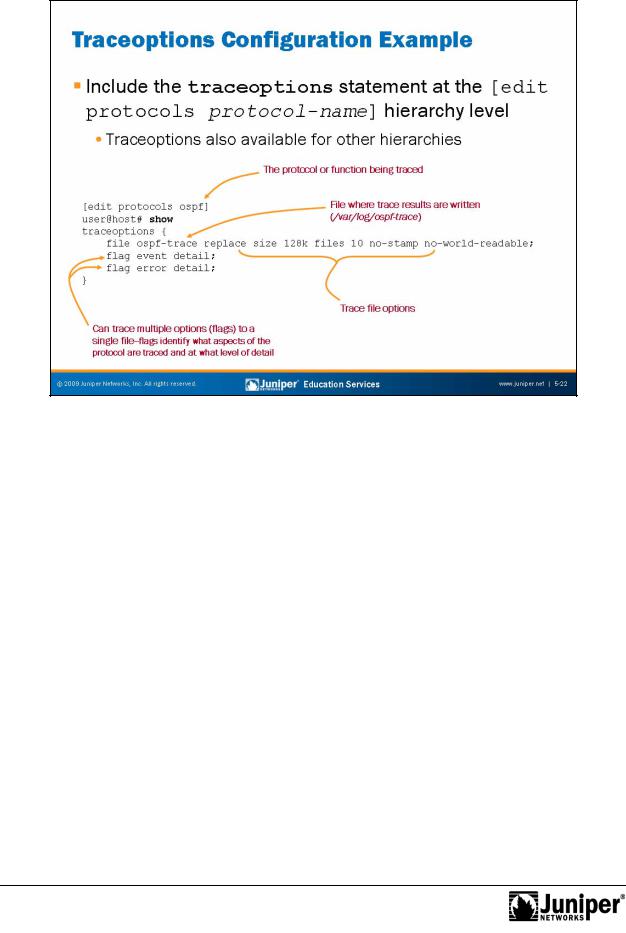
Introduction to JUNOS Software
Traceoptions ConfigurationReproductionExample
Trace the operations of a specific protocol by including the traceoptions statement at the [edit protocols protocol-name] hierarchy. In most cases you will wantforto be selective in what you trace because selecting the all keyword will likely provide t much detail. The sample Open Shortest Path First (OSPF) Protocol stanza on the slide reflects a typical tracing configuration that provides details about
NotOSPF even s and err rs. In many cases you will want to use the detail switch with a given pro ocol flag for the added information often needed in troubleshooting scenari s.
C ntinued on next page.
Chapter 5–22 • Secondary System Configuration
